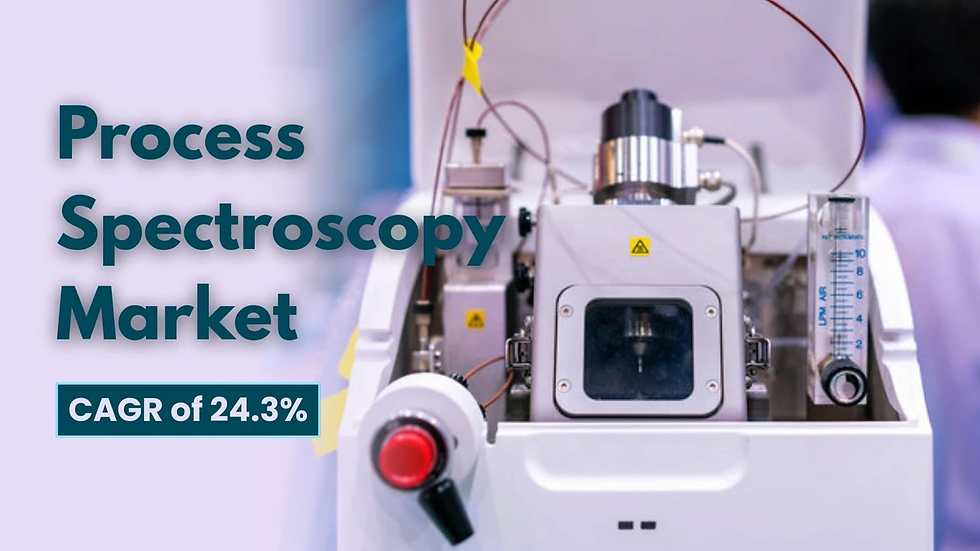Process Spectroscopy Market Insights, Growth, Share, Size and Forecast, 2024–2032
- Rishika Chavan
- Sep 5
- 4 min read
According to Fortune Business Insights™, the global process spectroscopy market was valued at USD 15.93 billion in 2023 and is projected to grow from USD 20.41 billion in 2024 to USD 116.49 billion by 2032, registering a CAGR of 24.3% during the forecast period. The increasing adoption of spectroscopy technologies for real-time analysis, product quality assurance, and operational efficiency is driving market growth across multiple industries.
What is Process Spectroscopy?
Process spectroscopy is an analytical technique used to monitor and analyze end products across industries. It enables companies to maintain high-quality standards, reduce operational time, and lower surveillance costs. Its applications are expanding in pharmaceutical safety testing, food inspection, oil and gas processes, and water treatment, contributing to the growing demand globally.
The technology helps optimize production processes, improve product quality, and ensure regulatory compliance. Moreover, the introduction of advanced spectroscopic instruments by major manufacturers is expected to further propel market growth during the forecast period.

Market Growth Factors
Rising Demand for High-Quality and Specialized Products
The growing consumer preference for high-quality products is driving the adoption of process spectroscopy. Spectroscopy enables the identification and quantification of chemical compounds, ensuring product quality in industries such as food & beverages, pharmaceuticals, and material sciences.
Companies are also leveraging spectroscopy to optimize production, comply with regulatory standards, and enhance operational efficiency. For instance, Exum Industries partnered with Edge Scientific to distribute its LALI-TOF-MS instruments in Canada, expanding the market reach for high-precision solid sample analysis.
Increasing Use of Mass Spectrometry in Drug Discovery
Mass spectrometry (MS) plays a critical role in drug discovery and development (DDD). It is widely used for monitoring drug metabolism, pharmacokinetics, pharmacodynamics, and lead optimization. MS-based screenings help identify compounds that bind to specific protein targets and monitor drug concentrations and metabolic pathways.
An example of market activity includes the October 2023 partnership between Sai Life Sciences and Dassault Systèmes, leveraging advanced solutions for drug discovery and research process optimization, accelerating pharmaceutical development.
Restraining Factors
High Initial Costs of Spectroscopy Instruments
The development, deployment, and maintenance of spectroscopic instruments require significant investment. High initial costs can be a barrier for new entrants, while operational expenses, such as protein identification in LC/MS analysis or large-scale proteomics experiments, further increase costs.
Rapid Technological Changes
Frequent updates and innovations in spectroscopy instrumentation, including mass spectrometry and process analytical systems, require constant investment by companies, which may hinder adoption among smaller players.
Information Source:
Market Trends
Adoption of Process Analytical Technology (PAT)
Process Analytical Technology (PAT) enables the design, analysis, and control of manufacturing processes by measuring critical parameters. PAT is particularly important in pharmaceutical manufacturing for monitoring reaction pathways and improving process safety.
In September 2023, the MAVERICK in-line Raman PAT system offered advantages over conventional Raman analyzers, providing cost-effective and accurate process monitoring without the complexities of traditional methods.
Market Segmentation
By Type: The Nuclear Magnetic Resonance (NMR) spectroscopy segment is the dominant and fastest-growing category, widely used across chemical, healthcare, and pharmaceutical industries due to its ability to provide detailed structural and molecular information. Infrared (IR) spectroscopy follows as the second-largest segment, valued for its capability to perform both qualitative and quantitative analysis of organic and inorganic compounds. Additionally, Ultraviolet-Visible (UV/VIS), Raman, and X-ray spectroscopy are contributing to market growth, particularly in specialized industrial applications that require precise material characterization.
By Technology: Atomic Absorption Spectroscopy (AAS) dominates the market due to its cost-effectiveness and suitability for high-throughput analysis of metals in various samples. The Atomic Emission Spectroscopy (AES) segment holds the second-largest position, offering high sensitivity and accuracy for trace element detection. Atomic Fluorescence Spectroscopy (AFS) accounted for a 17.31% market share in 2023 and is widely used for precise elemental analysis, adding significant value to the overall market.
By End-User: The food & beverage industry is the largest and fastest-growing end-user segment, driven by the increasing need for quality control, composition analysis, and nutritional assessment. The healthcare segment ranks second, with growth supported by the use of mass spectrometry in diagnostics, biomarker detection, and toxicology studies. Other industries, including agriculture, chemicals, oil & gas, and manufacturing, are also increasingly adopting spectroscopy techniques for process optimization and quality assurance.
By Component: The hardware segment led the market in 2023 and is projected to maintain the fastest growth, fueled by rising research and development efforts for advanced spectroscopic equipment. Meanwhile, the software segment is expected to witness significant expansion due to innovations in process control, data analysis, and automation solutions that enhance the efficiency and accuracy of spectroscopy applications.
Regional Insights
North America: Largest market, valued at USD 5.19 billion in 2023, driven by advanced research facilities, government initiatives, and presence of major players such as Bruker Corporation, Danaher, and Thermo Fisher Scientific.
Europe: Second-largest market, supported by government regulations, funding programs, and initiatives like Thermo Fisher Scientific’s IsoFootprint project for sustainable manufacturing.
Asia Pacific: Fastest-growing region, with key players including HORIBA, Shimadzu, and Yokogawa Electric Corporation, supported by new product launches and increasing adoption.
Rest of the World: Moderate growth due to rising investments in spectroscopy technology and infrastructure.
Key Industry Players
Leading players are focusing on R&D, technological advancements, and expanding distribution networks. Major companies include:
Agilent Technologies Inc. (U.S.)
ABB Ltd. (Switzerland)
BUCHI Labortechnik AG (Switzerland)
Bruker Corporation (U.S.)
Danaher Corporation (U.S.)
Foss A/S (Denmark)
HORIBA, Ltd. (Japan)
Kett Electric Laboratory (Japan)
Shimadzu Corporation (Japan)
Sartorius AG (Germany)
Thermo Fisher Scientific Inc. (U.S.)
Yokogawa Electric Corporation (Japan)
Recent Industry Developments
May 2024: Leading manufacturers showcased new innovations at Analytica 2024 in Munich, including advanced spectroscopy instruments for industrial and research applications.
January 2024: Bruker Corporation acquired Tornado Spectral Systems Inc., enhancing capabilities in advanced process Raman spectroscopy for pharmaceuticals and biotechnology quality control.



Comments